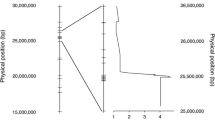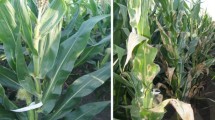Abstract
Quantitative trait loci (QTL) contributing to the frequency and severity of Ustilago maydis infection in the leaf, ear, stalk, and tassel of maize plants were mapped using an A188 × CMV3 and W23 × CMV3 recombinant inbred (RI) populations. QTLs mapped to genetic bins 2.04 and 9.04–9.05 of the maize genome contributed strongly (R 2 = 18–28%) to variation in the frequency and severity of U. maydis infection over the entire plant in both populations and within the majority of environments. QTLs mapped to bins 3.05, 3.08, and 8.00 in the A188 × CMV3 population and bin 4.05 in both populations significantly contributed to the frequency or severity of infection in only the tassel tissue. QTLs mapped to bin 1.07 in the A188 × CMV3 population and bin 7.00 in the W23 × CMV3 population contributed to U. maydis resistance in only the ear tissue. Interestingly, the CMV3 allele of the QTL mapped to bin 1.10 in the A188 × CMV3 population significantly contributed to U. maydis susceptibility in the ear and stalk but significantly increased resistance in the tassel tissue. Digenic epistatic interactions between the QTL mapped to bin 5.08 and four distinct QTLs significantly contributed to the frequency and severity of infection over the entire plant and within the tassel tissue of the A188 × CMV3 population. Several QTLs detected in this study mapped to regions of the maize genome containing previously mapped U. maydis resistance QTLs and genes involved in plant disease resistance.

Similar content being viewed by others
References
Agrios G (1988) Plant pathology, 3rd edn. Academic, New York
Billett E, Burnett J (1978) The host–parasite physiology of the maize smut fungus, Ustilago maydis. II. Translocation of 14C-labelled assimilates in smutted maize plants. Physiol Plant Path 12:103–112
Burnham CR, Cartledge C (1939) Linkage relations between smut reaction and semisterility in maize. J Am Soc Agro 31:924–931
Christensen JJ (1963) Corn smut caused by Ustilago maydis. American Phytopathological Society, St Paul
Christensen JJ, Stakman EC (1925) Physiologic specialization and mutation in Ustilago zeae. Phytopathology 16:979–999
Collins NC, Webb CA, Seah S, Ellis JG, Hulbert SH, Pryor A (1998) The isolation and mapping of disease resistance gene analogs in maize. Mol Plant-Microbe Interact 10:968–978
Cordero MJ, Raventos D, San Segundo B (1994a) Expression of a maize proteinase inhibitor gene is induced in response to wounding and fungal infection: systemic wound-response of a monocot gene. Plant J 6:141–150
Cordero MJ, Raventos D, San Segundo B (1994b) Differential expression and induction of chitinases and beta-1,3-glucanases in response to fungal infection during germination of maize seeds. Mol Plant-Microbe Interact 7:23–31
Darvasi A, Soller M (1992) Selective genotyping for determination of linkage between a marker locus and a quantitative trait locus. Theor Appl Genet 85:353–359
Gardiner JM, Coe EH, Melia-Hancock S, Hoisington DA, Chao S (1993) Development of a core RFLP map in maize using an immortalized F2 population. Genetics 134:917–930
Hallauer AR, Miranda JB (1981) Quantitative genetics in maize breeding. Iowa State University Press, IA
Hayes HK, Stakman EC, Griffee F, Christensen JJ (1924) Reactions of selfed lines of maize to Ustilago zeae. Phytopathology 14:268–280
Henderson CR (1950) Estimates of genetic parameters. Ann Math Stat 21:309–310
Hoover MM (1932) Inheritance studies of the reaction of selfed lines of maize to smut (Ustilago zeae). West Virginia Agri Expt Sta Tech Bull 253:1–32
Hueros G, Varotto S, Salamini F, Thompson RD (1995) Molecular characterization of BET1, a gene expressed in the endosperm transfer cells of maize. Plant Cell 7:747–757
Immer FR (1927) The inheritance of reaction to Ustilago zeae in maize. Minnesota Agri Expt Sta Tech Bull 51
Immer FR, Christensen JJ (1925) The reaction of selfed lines and crosses of maize to Ustilago zeae. Phytopathology 15:699–707
Immer FR, Christensen JJ (1928) Determination of losses due to smut infection in selfed lines of corn. Phytopathology 18:599–602
Kerns M, Dudley J, Rufener G (1999) QTL for resistance to common rust and smut in maize. Maydica 44:37–45
Kostandi SF, Geissler G (1989) Maize smut induced by Ustilago maydis (D. C.)—reaction of maize hybrids and lines to smut disease. J Agron Crop Sci 162:149–156
Lincoln S, Daly M, Lander E (1992) Constructing genetic maps with MAPMAKER/EXP 3.0. Whitehead Institute Tech Rep. White Institute, Cambridge
Lübberstedt T, Klein D, Melchinger A (1998) Comparative QTL mapping of resistance to Ustilago maydis across four populations of European flint-maize. Theor Appl Genet 97:1321–1330
Lynch M, Walsh B (1998) Genetics and analysis of quantitative traits. Sinauer Associates Inc., MA
Pataky JK, Chandler MA (2003) Production of huitlacoche, Ustilago maydis: timing inoculation and controlling pollination. Mycologia 95:1261–1270
Rohmeier T, Lehle L (1993) WIP1, a wound-inducible gene from maize with homology to Bowman-Birk proteinase inhibitors. Plant Mol Biol 22(5):783–792
Saboe LC, Hayes HK (1941) Genetics studies of reactions of smut and of firing in maize by means of chromosomal translocations. J Am Soc Agron 33:463–470
Saghai-Maroof M, Soliman K, Jorgensen R, Allard R (1984) Ribosomal DNA spacer-length polymorphisms in barly: mendelian inheritance, chromosomal location, and population dynamics. Proc Natl Acad Sci USA 81:8014–8018
Sandoval M, Corcuera VR (1998) Zea mays inbreds resistant to different populations of Ustilago maydis (DC) Corda. MNL 72:49
SAS Institute (1997) SAS user’s guide, version 6.13. SAS t, Cary
Searle S, Casella G, McCulloch VR (1992) Variance components. Wiley, New York
Shurtleff MC (1980) Compendium of corn diseases. American Phytopathological Society, St. Paul
Stakman EC, Christensen JJ (1926) Physiologic specialization and mutation in Ustilago zeae. Phytopath 16:979–999
Stringfield GH, Bowman DH (1941) Breeding corn hybrids for smut resistance. J Am Soc Agron 42:486–494
Utz H, Melchinger A (1997) PLABQTL: a program for composite interval mapping of QTL. J QTL: http://www.probe_nalusda.gov:8000/otherdocs/jqtl
Villanueva C (1997) “Huitlacoche” (Ustilago maydis) as a food source in Mexico. Micol Neotrop Apl 10:73–81
Webb C, Richter T, Collin N, Nicola M, Trick H, Pryor T, Hulbert S (2002) Genetic and molecular characterization of maize rp3 rust resistance locus. Genetics 162:381–394
White D (1999) Compendium of corn diseases. American Phytopathological Society, St Paul
Acknowledgments
The authors would like to acknowledge the help of both the Phillips and May lab in pollinations and scoring U. maydis infection. This project was supported through a NSF Biocomplexity Grant (DMS-0083468 to G. May), a graduate research grant given to Andrew Baumgarten from the University of Minnesota Center for Community Genetics, and support to Ron Phillips from MN Agricultural Experiment Station. Andrew Baumgarten’s work on this project was supported by graduate research assistantship from the Department of Agronomy and Plant Genetics, a fellowship from the University of Minnesota Plant Molecular Genetics Institute, and a University of Minnesota Doctoral Dissertation Fellowship. The authors would specifically like to thank Andy Dosdall for his efforts on this project.
Author information
Authors and Affiliations
Corresponding author
Additional information
Communicated by T. Lübberstedt.
Electronic supplementary material
Below are the links to the electronic supplementary materials.
Rights and permissions
About this article
Cite this article
Baumgarten, A.M., Suresh, J., May, G. et al. Mapping QTLs contributing to Ustilago maydis resistance in specific plant tissues of maize. Theor Appl Genet 114, 1229–1238 (2007). https://doi.org/10.1007/s00122-007-0513-5
Received:
Accepted:
Published:
Issue Date:
DOI: https://doi.org/10.1007/s00122-007-0513-5




